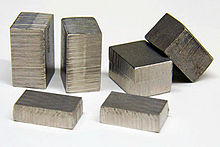Invar
Invar is an iron-nickel alloy with a very low coefficient of thermal expansion . It consists of 64% iron and 36% nickel . Invar is also sold under the names Invar 36, Nilo alloy 36, Nilvar, NS 36, Permalloy D, Radio metal 36, Vacodil 36. It has the material number 1.3912.
The name is also used as a generic term for a group of alloys and compounds which have the remarkable property of having abnormally small or sometimes negative coefficients of thermal expansion in certain temperature ranges . So the name is due to the Invar with respect to a temperature change ianz the strain.
Invar is a brand owned by Imphy Alloys, currently part of the Arcelor Mittal steel group . Invar alloys have found a wide range of applications in industry and are used where particular emphasis is placed on length stability in the event of temperature fluctuations.
history
The effect was discovered in 1896 by the Swiss physicist Charles Édouard Guillaume on the Invar alloy Fe65Ni35, who received the Nobel Prize in Physics for it in 1920 . He worked in the international weights and measures office looking for a cheap material to make length and mass standards. At that time, these standards, such as the original meter , were made from a platinum - iridium alloy.
Alloys
Fe65Ni35-Invar contains 65% iron and 35% nickel. Up to 1% magnesium , silicon and carbon are alloyed to change the mechanical properties. By alloying 5% cobalt , the coefficient of thermal expansion can be further reduced. One name for the alloy is Inovco , Fe-33Ni-4.5Co, α (20-100 ° C) of 0.55 ppm / K.
Variants of this alloy have a slightly different coefficient of thermal expansion. Kovar has an expansion coefficient of approx. 5 ppm / K.
Many other alloys are now known to exhibit an invar effect:
- face-centered cubic (fcc): FeNi, FePt, FePd, FeMn, CoMn, FeNiPt, FeNiMn, CoMnFe and many more.
- body-centered cubic (bcc): CrFe, CrMn
- hexagonal close packing of spheres (hcp): CoCr
- amorphous: FeB, FeP and many more
- "Indilatans extra" (Krupp): (36Ni, XX) with an expansion coefficient of −0.04 ppm between 12 ° C and 100 ° C
- Supra-Invar (32.5Ni, 4.0Co) should have 0ppm expansion coefficient at 20 ° C
Laves phases and compounds: TiFe 2 , ZrFe 2 , RECo 2 (RE = rare earths except Eu), FeC, Dy2 (FeCo) 17, etc. a.
properties
Using the example of Fe65Ni35-Invar:
- specific electrical resistance = 0.75-0.85 Ωmm 2 / m,
- Young's modulus = 140-150 GPa,
- Brinell hardness = 160,
- Elongation at break <45%,
- Tensile strength = 450-590 MPa,
- Density = 8 g / cm³,
- Linear expansion coefficient at 20–90 ° C = 1.7–2.0 · 10 −6 K −1 ,
- Thermal conductivity at 23 ° C = 13 Wm −1 K −1
Physical background
The Invar effect is based on a negative volume magnetostriction of the crystal lattice . This means that by repelling the magnetic moments of the individual atoms of the alloy, the lattice is "inflated", thus increasing the distances between the atoms. However, this effect decreases with increasing temperature (since the magnetic moments decrease) and thus causes the crystal lattice to shrink. The decrease in negative volume magnetostriction with increasing temperature is therefore contrary to thermal expansion , which increases the distance between atoms. These physical phenomena can compensate each other in certain temperature ranges in such a way that the atomic distances do not change effectively and the solid does not experience any change in length (or change in volume). The Invar effect disappears together with the magnetic moments of the atoms from the respective magnetic order temperature of the material, i.e. the Curie temperature or the Néel temperature .
Area of use
Invar was first used to make cheap mass and length standards. It was also used to make precision pendulum clocks and chronometers . One half of bimetals is often made from invar.
Invar alloys are used for a wide range of products that require high length stability in the event of temperature fluctuations. Examples are perforated masks for picture tubes , glass-metal junctions, tanks of liquid gas ships ( membrane tanks ), chip base plates, laser housings, waveguides and astronomical and seismographic instruments. The development of a method for welding Invar has expanded the range of applications. In geodesy , wires made of Invar are used in precision leveling staffs and for high-precision distance measurement in short distances (up to approx. 20 m), e.g. B. in tunnel or dam construction. When processing large CFRP components, for example in the aerospace industry, the corresponding lamination tools are partly made from Invar, since CFRP components also have a low thermal expansion (negative coefficient of thermal expansion). In the autoclave process, it is ultimately advantageous if the thermal expansions of the tool and workpiece are as equal as possible.
See also
Web links
- The physical puzzle, the invar effect, has been cleared up. ( Memento from November 3, 2004 in the Internet Archive ) In the original on Wissenschaft.de from July 1, 1999.
Individual evidence
- ↑ Hübschmann / Links: Tables for Chemistry, Verlag Handwerk und Technik GmbH, Hamburg, 1991, ISBN 3-582-01234-4 , p. 35: Coefficients of expansion of metal alloys (materials), glasses and inorganic chemicals.
- ↑ Hübschmann / Links: Tables for Chemistry, Verlag Handwerk und Technik GmbH, Hamburg, 1991, ISBN 3-582-01234-4 , p. 35: Coefficients of expansion of metal alloys (materials), glasses and inorganic chemicals.



